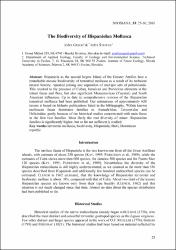/admin/item?itemID=f45bb789-1f1f-4590-8c4e-68fc24d65ccc
The biodiversity of Hispaniolan mollusca

View/
Type of Access
OpenMaterial Type
ArticleType of Content
Scientific researchLanguage
EnglishCollection
- Investigación ambiental [1743]
Metadata
Show full item record| Abstract: | Hispaniola as the second largest Island of the Greater Antilles host a remarkable mosaic biodiversity of terrestrial mollusca as a result of its turbulent natural history: repeated joining and separation of multiple sets of paleoislands. This resulted to the presence of Cuban, Jamaican and Portorican elements in the island fauna and flora, but also significant Mesoamerican (Yucatan) and South American influences. Up to date no comprehensive revision of the Hispaniolan terrestrial mollusca had been published. Our estimations of approximately 620 taxons is based on hitherto publications listed in the bibliography. Within known molluscan fauna dominates families as Annualriidae, Urocoptidae and Helicinidae, partly because of the historical studies concentrated with main focus in the first two families. Most likely the real diversity of minor Hispaniolan families is significantly higher, but so far not sufficiently studied. |
| Author(s): | Grego, Jožef
Šteffek, Jožef |
| Date: | 2016 |
| Published: | Soosiana, 33, 25-30 |
| Citation: | Grego, J., & Šteffek, J. (2016). The biodiversity of Hispaniolan mollusca. Soosiana, 33, 25-30. Recuperado de: |
| URI: | https://bvearmb.do/handle/123456789/3494
|
